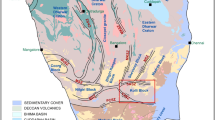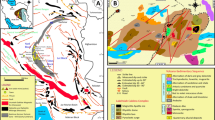Abstract
Distribution coefficients (K D·Fe ++ −Mg) calculated for orthopyroxene-clinopyroxene pairs from 12 basic granulites of the Quairading district, Western Australia, range from 1.87 for magnesian pyroxenes (Opx Mg value=78.1) to 1.70 for iron-rich varieties (Opx Mg value 37.7). Field and petrographic evidence indicates that these pyroxenes have probably reached equilibrium within a narrow temperature range. In order to account for the observed variation of K D values it is suggested that one (or both) of the pyroxene structures is not the ideal Fe++-Mg “solution” proposed in the thermodynamic model of the pyroxene equilibrium exchange. After consideration of the geometry of the pyroxene cation sites, the relative bond energies of each site (especially crystal field stabilization energy) and structural ordering a model is proposed to explain the non-ideal behaviour of Fe++-Mg in the pyroxene system. The distribution pattern in low-iron pyroxenes will probably show Fe++ favouring the M 2·Opx site; competing unfavourably with Mg++ for the M 1·Cpxsite; and probably excluded by Mg++ from the M 1·Opxsite. As the iron content of the system increases the M 2·Opxsite will begin to become saturated with Fe++ and this ion will enter the M 1·Opx site. Further increases in the iron content of the system will cause the Fe++-Mg distribution to depend increasingly on the relative attraction of the M 1 sites of both pyroxenes. Of these sites Fe++ should show preference to the more distorted M 1·Cpxsite. The distribution coefficient reflects this swing towards a relative enrichment of Fe++ in the clinopyroxene by decreasing regularly with increasing iron content. It is likely that this downward trend will not become evident until the iron content of the M 2·Opx site reaches saturation. This would explain why the K D values for the magnesian pyroxenes remain practically unchanged until the orthopyroxene Mg value is approximately 60; from here on the iron-rich pyroxenes show a rapid decrease in K D value with increasing iron content.
The Ca content of the pyroxenes is also significant since the Quairading pyroxenes show a marked increase in mutual solubility with increasing iron content. Calcium taken into the orthopyroxene structure will enter the M 2 site ahead of Fe++ so that this site will reach Fe++ saturation at a lower iron content than when the orthopyroxene is Ca-free.
The application of K D values to the regional study of basic granulites, particularly when establishing relative temperature zones on the basis of K D variation, should only be attempted when pyroxenes which extend over a wide range of Fe-Mg content are available.
Similar content being viewed by others
References
Bancroft, G. M., R. G. Burns, and R. A. Howie: Determination of the cation distribution in the orthopyroxene series by Mössbauer effect. Nature 213, 1221–1223 (1967).
—, A. G. Maddock, and R. G. Burns: Applications of the Mössbauer effect to silicate mineralogy. I. Iron silicates of known crystal structure. Geochim. et Cosmochim. Acta 31, 2219–2246 (1967).
Binns, R. A.: Metamorphic pyroxenes from the Broken Hill district, New South Wales. Mineral. Mag. 33, 320–338 (1962).
—: Zones of progressive regional metamorphism in the Willyama Complex, Broken Hill district, New South Wales. J. Geol. Soc. Australia 11, 283–330 (1964).
Davidson, L. R.: Chemistry and paragenesis of some metamorphic orthopyroxenes. Ph. D. Thesis, University of Cambridge (1965).
Deer, W. A., R. A. Howie, and J. Zussman: Rock forming minerals, vol. 2, Chain silicates. London: Longmans, Green & Co. Ltd. (1963).
Ghose, S.: Mg2+-Fe2+ order in an orthopyroxene, Mg0.93Fe1.07Si2O6. Z. Krist. 122, 81–99 (1965).
Guggenheim, E. A.: Thermodynamics. Amsterdam: North Holland Publ. Co. (1959).
Himmelberg, G. R., and Wm. C. Phinney: Granulitefacies metamorphism, Granite Falls — Montevideo Area, Minnesota. J. Petrol. 8, 325–348 (1967).
Kretz, R.: Some applications of thermodynamics to coexisting minerals of variable composition. Examples: orthopyroxene-clinopyroxene and orthopyroxene-garnet. J. Geol. 69, 361–387 (1961).
—: Distribution of magnesium and iron between orthopyroxene and calcic pyroxene in natural mineral assemblages. J. Geol. 71, 773–785 (1963).
—: Interpretation of the shape of mineral grains in metamorphic rocks. J. Petrol. 7, 68–94 (1966).
Leelanandam, C.: Chemical study of pyroxenes from charnockitic rocks of Kondapalli (Andhra Pradesh), India, with emphasis on the distribution of elements in coexisting pyroxenes. Mineral. Mag. 36, 153–179 (1967).
Mueller, R. F.: Compositional characteristics and equilibrium relations in mineral assemblages of a metamorphosed iron formation. Am. J. Sci. 258, 449–497 (1960).
Nockolds, S. R.: The behaviour of some elements during fractional crystallization of magma: Geochim. et Cosmochim. Acta 30, 267–278 (1966).
Orgel, L. E.: An introduction to transitionmetal chemistry: Ligand-field theory. London. Methuen (1966).
Peters, T.: Distribution of Mg, Fe, Al, Ca and Na in coexisting olivine, orthopyroxene and clinopyroxene in the Totlap serpentinite (Davos, Switzerland) and in the Alpine metamorphosed Malenco serpentinite (N. Italy). Contr. Mineral. and Petrol. 18, 67–75 (1968).
Prider, R. T.: Charnockitic and related cordierite-bearing rocks from Dangin, Western Australia. Geol. Mag. 82, 145–172 (1945).
Ramberg, H., and G. Devore: The distribution of Fe++ and Mg++ in coexisting olivines and pyroxenes. J. Geol. 59, 193–210 (1951).
Schwarz, H. P.: The effect of crystal field stabilization on the distribution of transition metals between metamorphic minerals. Geochim. et Cosmochim. Acta 31, 503–517 (1967).
Wilson, A. F.: Advances in the knowledge of the structure and petrology of the Precambrian rocks of south-western Australia. J. Roy. Soc. W. Australia 41, 57–83 (1958).
—: The charnockitic rocks of Australia. Geol. Rundschau 47, 491–510 (1959).
—: The charnockitic granites and associated granites of Central Australia. Trans. Roy. Soc. S. Australia 83, 37–76 (1960a).
—: Coexisting pyroxenes: Some causes of variation and anomalies in optically derived compositional tielines, with particular reference to charnockitic rocks. Geol. Mag. 97, 1–17 (1960b).
Author information
Authors and Affiliations
Rights and permissions
About this article
Cite this article
Davidson, L.R. Variation in ferrous iron-magnesium distribution coefficients of metamorphic pyroxenes from Quairading, Western Australia. Contr. Mineral. and Petrol. 19, 239–259 (1968). https://doi.org/10.1007/BF00508913
Received:
Issue Date:
DOI: https://doi.org/10.1007/BF00508913




